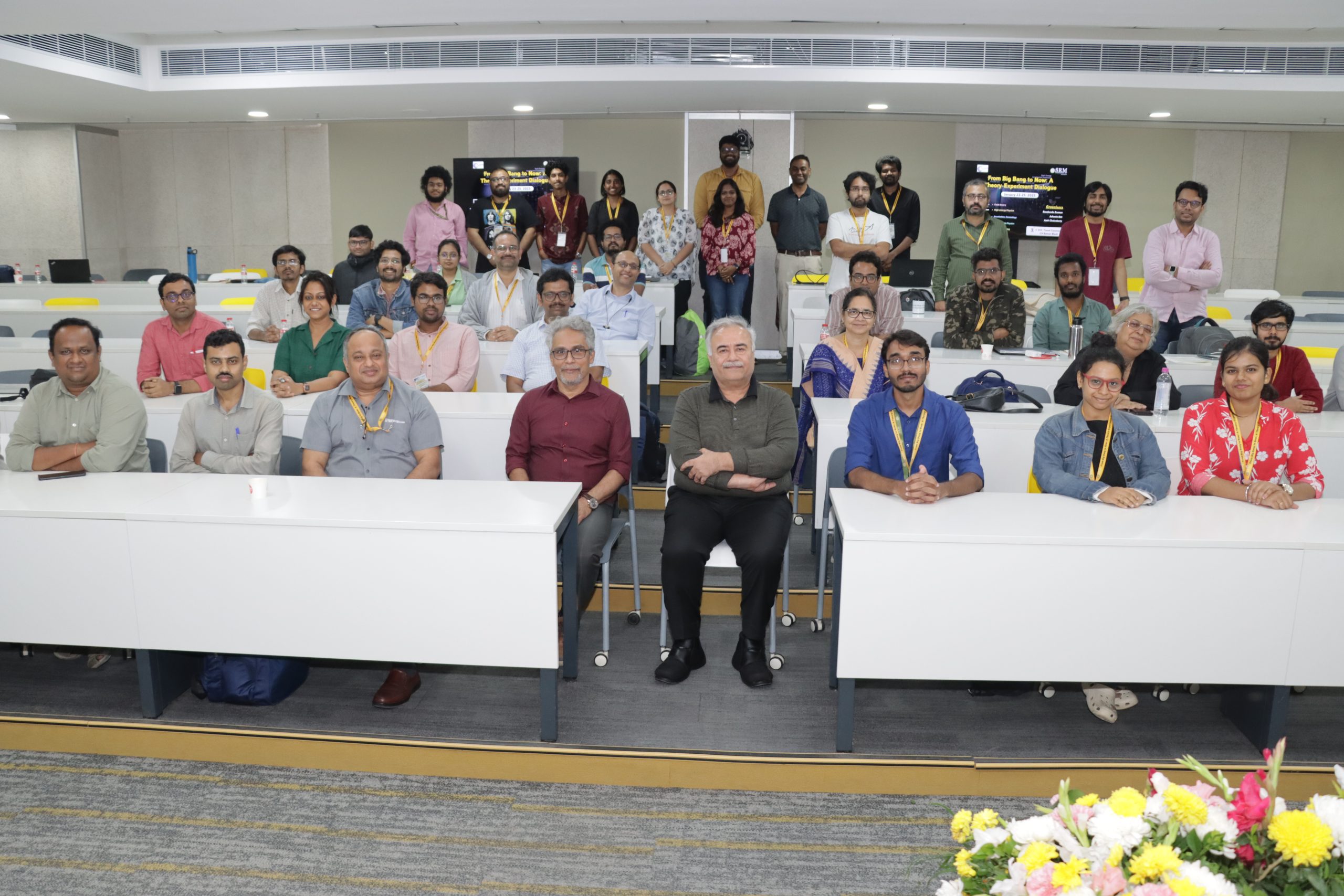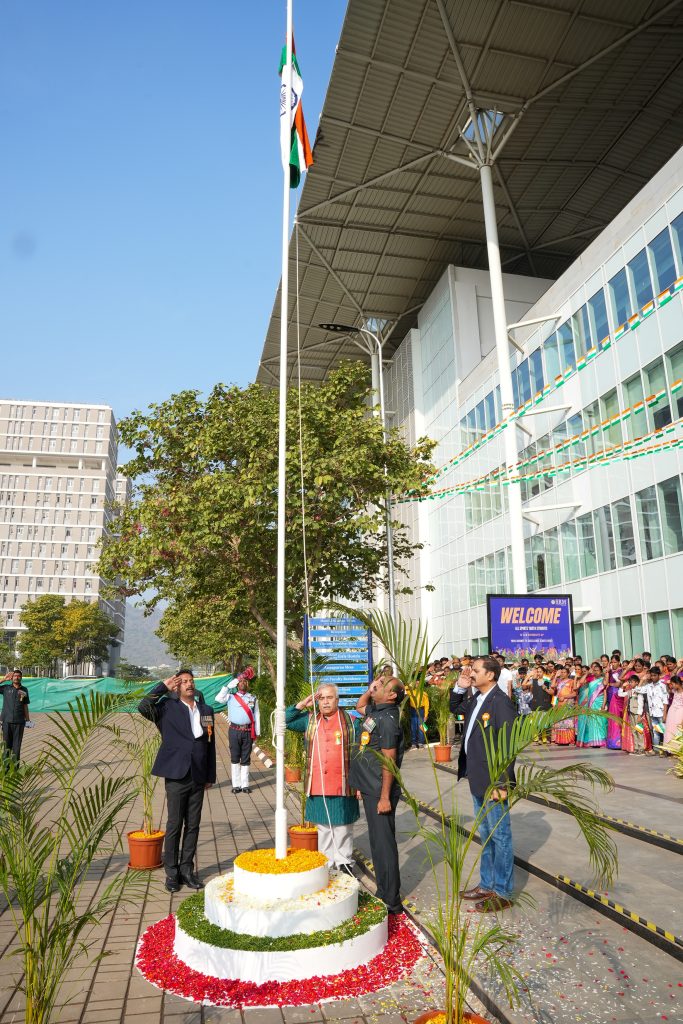3-Day Conference on “From Big Bang to Now” Concludes
 The Department of Physics organised a 3-day conference on “From Big Bang to Now : A Theory-Experiment Dialogue.” The event witnessed the presence of – Prof. Ranjit Thapa, Dean-Research; Dr C V Tomy, Dean-School of Engineering and Sciences, Dr Pranab Mandal, Head – Department of Physics, Prof. Sreerup Raychaudhuri along with Assistant Professors Dr Ashmita Das, Dr Basabendu Barman and Dr Amit Chakraborty.
The Department of Physics organised a 3-day conference on “From Big Bang to Now : A Theory-Experiment Dialogue.” The event witnessed the presence of – Prof. Ranjit Thapa, Dean-Research; Dr C V Tomy, Dean-School of Engineering and Sciences, Dr Pranab Mandal, Head – Department of Physics, Prof. Sreerup Raychaudhuri along with Assistant Professors Dr Ashmita Das, Dr Basabendu Barman and Dr Amit Chakraborty.
As part of the inaugural address Dr C V Tomy highlighted the varsity’s prowess in terms of its accomplishments for a relatively young University, he stated that the varsity’s H-index of 59 reflects its significant global impact, the department of physics has also been the FIST sponsored Department among many other departments in the university.
Prof. Ranjith Thapa in his address stated, “SRM University-AP is a self-reliant institution, generating its own resources to fund cutting-edge research and education,” he also welcomed students to be a part of the academic community at SRM AP.
The Department head, Dr Pranab Mondal stated, “Since the inception we have grown tremendously as a department and as a university, both in terms of academic output and research impact. We also focus on actively collaborating with other departments to focus on not just research but also on advancing higher education and have strived to make the department what it is today.”
Prof. Sreerup Rayachaudhuri, visiting professor at the varsity and former professor at the TIRF said, “There are 4 categories of universities in India, the IITs, the private universities, the government universities and research institutes. Although SRM AP is a private university, it strongly encourages research, the very existence of this conference today, exemplifies the varsity’s commitment to fostering research culture.”
The conference also featured engaging presentations and lectures by students and faculty from various prestigious institutions across India. The event served as a platform for knowledge exchange, and networking, further strengthening SRM University-AP’s reputation as a hub for academic and research excellence.
The 3-day conference concluded with a renewed commitment to spreading knowledge in the field theory, high-energy physics, Astroparticle physics and Machine Learning, ensuring that SRM University-AP continues to contribute significantly to global scientific progress.
- Published in Departmental News, News, Physics News
Student Athelete Deepthi Jeevanji Felicitated for Winning the Arjuna Award

SRM University-AP honoured the accomplishments of its student and Paris Paralympian, Ms Deepthi Jeevanji, who is a recipient of the Arjuna Award this year on January 24, 2025. Deepthi, a student of commerce at the Paari School of Business, represented India at the Paris Paralympics 2024 in the 400-meter T20 event and secured a bronze medal, becoming the first intellectually impaired Indian athlete to win a Paralympic medal.
The felicitation ceremony featured Vice Chancellor Prof. Manoj K Arora, Registrar Dr R Premkumar, Director of Campus Life and Maintenance and Director I/C of Sports, Mr Anup Suryavanshi and Former IIT Madras Faculty, Prof. N Siva Prasad presented Ms Jeevanji with award cheques of rupees twenty-five lakh for her Paralympic success and an additional fifteen lakh rupees for winning the Arjuna Award.
The event served as a platform to encourage aspiring students to pursue sports and consider it as a career option. During the ceremony, Deepthi expressed her gratitude, stating, “It is an immense honour to represent my country on such a prestigious global platform. The support from the management, staff, and my teachers at SRM University-AP played a crucial role in helping me achieve success.”

Vice Chancellor Prof. Manoj K Arora highlighted the importance of sports in education and the university’s commitment to fostering a culture of excellence. He stated, “We are proud of her achievement and hope she participates in the next Paralympics too, bringing gold to the country.” He also emphasised that the university is here to provide any form of support for her way forward in sports. Registrar Dr R Premkumar acknowledged Deepthi’s remarkable accomplishment and expressed pride in her historic success.
Director – Campus Life and Maintenance and Director I/C of Sports, Mr Anup Singh Suryavanshi, mentioned in the press meeting that followed, SRM University-AP has allocated seventy lakh rupees to encourage its high-performing students in sports. He noted that the university’s sporting infrastructure is on par with international standards and welcomes students from across the country to join its Sports Department.
The felicitation event also saw the announcements of the university’s upcoming National-Level Sports Fest, UDGAM 2025 which will see participation from over 3,200 students from across the country. Arjuna Awardee Ms Deepthi Jeevanji unveiled the event brochure to the members of the media.
- Published in News, Sports News, Students Achievements
76th Republic Day Celebrations: Student-Athlete and Olympian Jyotika Sri Dandi Rewarded with Cash Prize

SRM University-AP honoured the 76th Year of India as a Republic with regal celebrations at the campus. Vice Chancellor Prof. Manoj K Arora hoisted the flag in the presence of Registrar Dr R Premkumar, Deans and Directors, faculty, staff and students, followed by a parade by the security staff of the university. Ms Jyotika Sri Dandi, student of Easwari School of Liberal Arts who represented the Indian team at the Women’s 4x400m Relay for the Paris Olympics 2024, was also present for the occasion.
In his address, Prof. Manoj K Arora spoke about the country’s golden heritage and the battle for freedom led by our freedom fighters and visionary leaders, which led to the momentous victory of Purna Swaraj. He underscored the significance of our Constitution representing the values that unite the diverse nation. “Our country has developed in leaps and bounds with our pivotal position on the global economic front, achievements in education and sports, and our advanced space programme. India is on its way to becoming a developed nation by 2047, and we must strive together as citizens to achieve this inclusive vision,” stated Prof. Arora in his address. He also briefed on the university’s stellar growth in academics, research and innovation, entrepreneurial startups, infrastructure and the plan for the upcoming year.
The celebration also witnessed the felicitation of the student-athlete and Olympian, Ms Jyotika Sri Dandi, who participated in the Paris Olympics 2024. The university awarded her a reward cheque of Rs 20 Lakhs for her remarkable contribution to Indian sports and her alma mater. In her address of gratitude, she stated, “SRM University-AP provided me with immense support for my academics with scholarships and the best resources for training. With two Olympians already in its fold, I am sure that in 10 years we will harbour the best contingent of athletes and academicians among all Indian universities.”
Pro-Chancellor Dr P Sathyanarayanan sanctioned Rs 70 lakh to be awarded to students who have won various national and inter-university sports championships. Cash prizes ranging from Rs 15,000 to Rs 1,00,000 were awarded to student-athletes for their exemplary sports performances during the event. Faculty and staff who have rendered five years of service to the university were also honoured with a memento and certificate in recognition of their contribution to the university’s development. The Republic Day celebrations concluded with various cultural programmes by students celebrating the diversity of the great nation.
- Published in Events, News, University Event
SRM AP Partners with Uniglobus Electrical and Electronics Pvt. Ltd. for EC-less LED Lighting Research

In a significant stride towards advancing sustainable energy technologies, SRM University-AP has signed an Memorandum of Understanding (MoU) with Uniglobus Electrical and Electronics Pvt. Ltd. The collaboration aims to develop cutting-edge EC-less LED lighting systems through a joint research initiative. The partnership was formalised following an exploratory visit by Uniglobus representatives, Mr Gajanan Inamdar and Mr Saurabh Maheta, to SRM AP. During their visit, they engaged in extensive discussions with the university faculty, identifying EC-less LED drivers as a promising area for impactful research.
Dr Ramanjaneya Reddy Udumula, Assistant Professor from the Department of Electrical and Electronics Engineering, will lead this innovative project as the Principal Investigator. Highlighting the significance of the collaboration, he noted, “This research initiative will address critical challenges in energy-efficient lighting while fostering a bridge between academic insights and industrial expertise.”
Uniglobus has also invited Dr Udumula to visit its state-of-the-art facilities to gain an in-depth understanding of their advanced product line. This visit underscores the mutual commitment to fostering a symbiotic relationship between academia and industry, paving the way for groundbreaking technological advancements.
Key figures instrumental in making this collaboration a reality include Vice Chancellor Prof. Manoj K. Arora, Prof. Ranjit Thapa, Dean of Research; Prof. Vinod Kumar G S, Associate Dean of the Technology Transfer Cell; and Prof. C.V. Tomy, Dean of the School of Engineering and Applied Sciences (SEAS). Their collective efforts, alongside the support of Mr BS Praveen from Uniglobus, have laid the foundation for this transformative partnership.
The project focuses on addressing critical global challenges associated with energy sustainability and efficiency. With the rapid industrial growth and increasing global population driving energy demand, the limitations of conventional energy sources have become a pressing concern. Governments and industry leaders worldwide are calling for innovative solutions to promote energy-saving and sustainable technologies.

A Game-Changing Innovation
The research aims to develop an Electrolytic Capacitor (EC)-less, ripple-free LED driver system. Unlike conventional LED drivers, this system employs a DC-DC converter as a power factor correction (PFC) unit and a bi-directional buck-boost converter (BDC) to eliminate second harmonic ripples. This configuration simplifies control mechanisms while ensuring high power factor and reduced total harmonic distortion, delivering a steady DC current to the LED load.
Towards a Sustainable Future
This collaboration marks a significant milestone in addressing sustainability challenges through innovation. By merging the academic expertise of SRM University-AP with the industrial insights of Uniglobus Electrical and Electronics Pvt. Ltd., the partnership seeks to deliver impactful solutions for a greener, more sustainable future.
The MoU underscores SRM University-AP’s commitment to fostering innovation through strategic collaborations, positioning the institution at the forefront of research and technological development in energy efficiency. Both partners look forward to a fruitful and enduring collaboration that promises to benefit society at large.
- Published in Departmental News, EEE NEWS, MoU, News, Research News
















